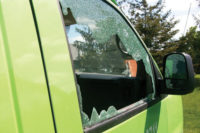Securing a Worksite to Prevent Equipment Theft

Heavy equipment from restoration businesses is one of the most common targets for thieves. Construction and contracting worksites can lose thousands of dollars every year due to equipment theft. To protect a jobsite, restoration business should consider the following steps.
Start With the Basics
Theft can cost the construction industry up to $1 billion each year, according to the National Equipment Register (NER). To help protect against this threat level, restoration businesses will need to start with the basics.
Locking doors, closing windows and setting the alarm system should be standard practices in the workplace. Additional measures can then add more protection. Security cameras can help identify or stop thieves, as can proper lighting, since they tend to gravitate toward darker sites.
Signage and fencing can ward off intruders, as well. Signs can show miscreants the area is under surveillance and that the site takes action against any form of theft. Chain-link fencing adds an obstacle that will deter some intruders.
Storage is also a deciding factor for security. If the equipment remains outside overnight, then these precautions are necessary. If workers bring the machinery inside, managers can add an extra layer of protection by storing it safely under lock, key and security system.
Keep Records
Keeping records is the next essential step. To properly keep track of equipment in the workplace, managers must keep files on each item. This includes writing down the make, model, serial number, date of purchase and value at that time, year built, and any other details that can help with identification should it go missing.
Digital versions of records are a useful primary source, too. Paper versions are good backups, but managers can access digital files from anywhere. This accessibility is an important feature since theft can happen at any time, and the company will need to respond quickly.
Managers should also register their heavy equipment through the NER to ensure more protection. The NER's database provides a centralized list of all stolen heavy equipment. Site managers will be able to see the ownership of the machine and retrieve it faster.
Use Technology
A piece of equipment can cost up to $17,000 on average. Technology makes it easy for even small and midsize business owners to take additional security measures and preserve the investment. One of the best ways to do this is through fleet tracking software. This technology can provide location data as well as usage information. Business owners can track any unscheduled use of the machinery or equipment and receive the longitude and latitude coordinates.
Other technology includes geofencing, a tool that lets managers set virtual GPS boundaries around the work area. They receive a notification once the equipment crosses those boundaries.
Both of these options are ready and available for managers to implement. They are tools that quickly provide a return on investment (ROI) should thieves steal any equipment.
Hire the Right People
Employees and clients are critical parts of any workforce, but managers need to ensure they work with the right people. Proper training is essential for employees to learn standard security protocols. In addition, managers should only give security access to select people to limit the probability of theft.
Clients and customers are another area of focus. Before working with anyone new, site owners can look into the client's history, reviews and reliability. Once they check out, managers know they're working with the right people and ensuring no sketchy characters are in the deal.
Finally, security guards can be invaluable to a restoration business. They add an extra level of safety and protection for equipment. They may also provide better accounts of any theft if security cameras don't have the best video quality.
What to Do in Instances of Theft
The first thing a manager should do in any instance of theft is report it to the NER. The quicker they do so, the more likely the organization can recover the equipment. Tracking tech, security measures, records and proper staffing will all prove useful in reclaiming machinery.
Looking for a reprint of this article?
From high-res PDFs to custom plaques, order your copy today!







